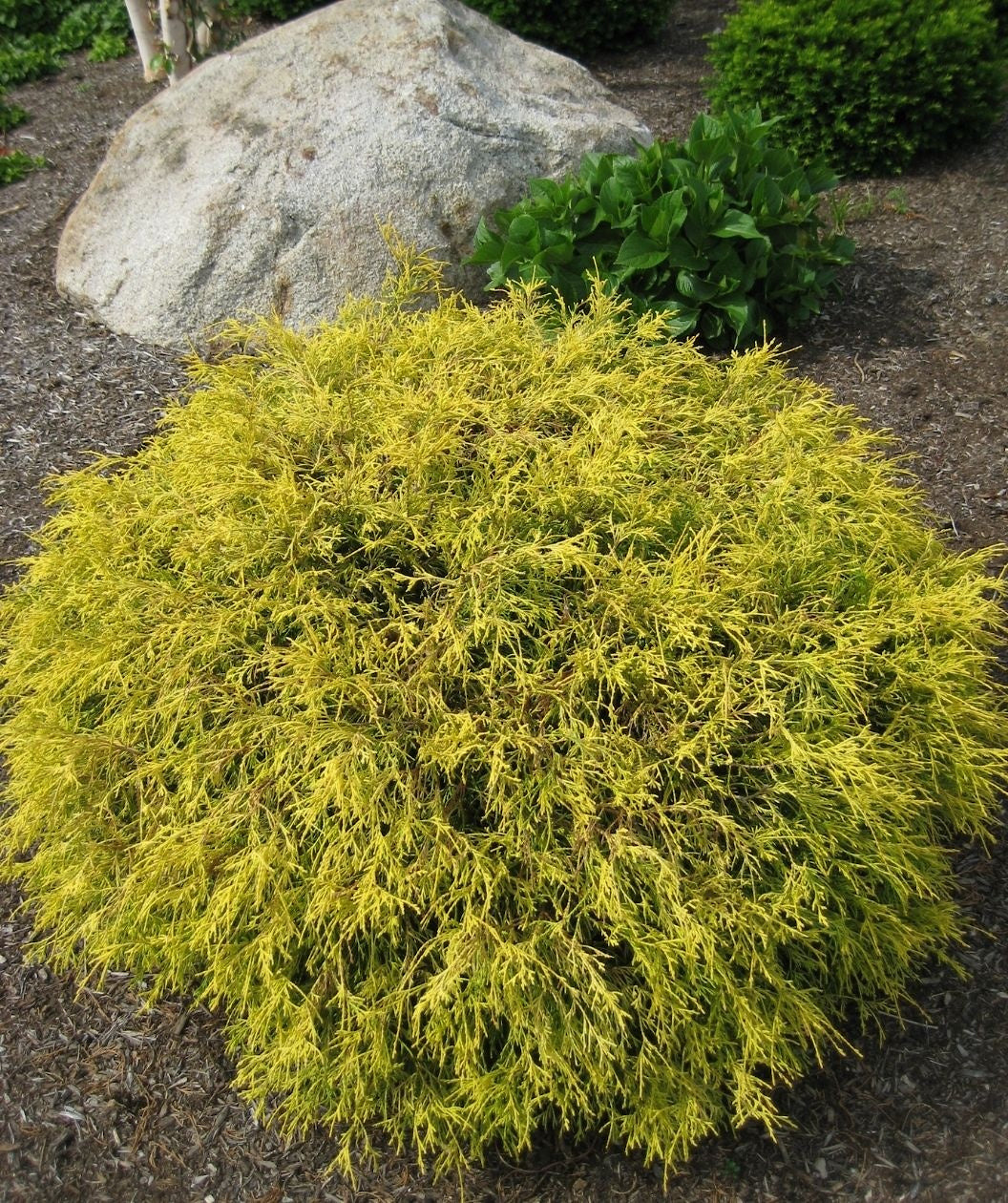

DWARF, GOLDEN COLORED EVERGREEN SHRUB WITH A HUGE PERSONALITY
FEATURES:
- Bright, golden yellow color year round
- Easy care dwarf evergreen shrub
- Drought tolerant and cold hardy
- A great 'pop' of color anywhere in the landscape
- Hand Selected, Fresh from the Grower
- Ships on our trucks because of the size of the tree - does not fit in a box
Growth Facts
- Hardiness Zone: 5-7
- Mature Height: 3-5' tall
- Mature Width: 3-5' wide
- Exposure: Full Sun/Part Shade
- Spacing: 3-5' apart
DWARF, GOLDEN COLORED EVERGREEN SHRUB WITH A HUGE PERSONALITY
FEATURES:
- Bright, golden yellow color year round
- Easy care dwarf evergreen shrub
- Drought tolerant and cold hardy
- A great 'pop' of color anywhere in the landscape
- Hand Selected, Fresh from the Grower
- Ships on our trucks because of the size of the tree - does not fit in a box
Growth Facts
- Hardiness Zone: 5-7
- Mature Height: 3-5' tall
- Mature Width: 3-5' wide
- Exposure: Full Sun/Part Shade
- Spacing: 3-5' apart
Why plant Golden Mop Falsecypress Big?
Fluffy and Fine, Everybody loves Golden Threadleaf False Cypress (or Golden Mop)! Falsecypress, a very cool dwarf yellow version of the Sawara Falsecypress Tree. This perky, vibrant yellow evergreen will bring a cheerful burst of color to your landscape and offers an interesting texture that you’ll be tempted to run your fingers through. Instead of wearing the typical needles of most conifers, like Spruce, Pine, and Fir, Gold Mop Falsecypress is draped in curious thin ropy foliage from head to toe. Give this fun accent plant a prominent spot in any of the landscape beds around your home, and it will mix beautifully with other green-, blue-, and purple-foliaged plants and will shine like a beacon all year long.
Native to Japanese islands Honshu and Kyushu, Chamaecyparis pisiferia or Sawara Cypress is an evergreen conifer that can grow upwards of 50 ft. in the wild. Original species plants typically are not sold and planted in today's landscapes; however, smaller cultivars are more popular and common in landscapes. Sawara Falsecypress is a stately Japanese forest tree that can reach 100 feet or more in the wild. Fortunately, there are many versions of Sawara that stay much smaller, and some of them have blue or gold foliage to boot (like Gold Mop). There is some confusion as to where and when this version appeared and even what to call it. It goes by the names ‘Gold Mop’, ‘Golden Mop’, ‘Golden Mops’, or just ‘Mops’. This selection probably came out of Europe in the 1950s or ’60s. It has been embraced by gardeners all over the world (with good reason) and is the most popular of all the Sawara Falsecypresses that are grown.
How to use Golden Mop Falsecypress Big in the landscape?
Golden Threadleaf is a mounded, dwarf variation. Slow-growing, Golden Threadleaf can mature up to 5 ft tall, 2-3 ft of growth coming from the first decade of growth. As an evergreen, the golden yellow/green foliage maintains its color year-round. This slow grower is easy to control with regular light pruning, however, if space is at a premium. A great addition to any landscape needing four-season color!
Planting Zones
Hardiness Zone: 5-7
How To Plant Golden Mop Falsecypress Big
Gold Mop Falsecypress is an adaptable, easy-to-grow specimen plant for full sun. One situation it doesn’t care for is extreme heat and humidity, and in the Deep South ,it may struggle. In much of the rest of the country, though, it’s a trooper that thrives with little special care. Give it regular water and a layer of mulch to keep the roots cool and moist. Gold Mop Falsecypress will grow in shade, but the foliage will turn green there, so make sure it has plenty of light. Pests and diseases are normally of no concern as long as the plant isn’t stressed or overwatered.
How To Water
Water twice weekly for the first 3-5 weeks; then water weekly for the remainder of the year until winter. When you water, water very slowly and very thoroughly. The water needs to reach to the bottom of the root ball and that takes time. Watering needs may be altered due to extreme weather conditions.
How To Fertilize
Incorporate Elements Starter Plant Food granular form into the soil when planting. If planting in spring or summer, start fertilizing late fall using Elements Starter Plant Food granular form on an annual basis each late fall. Continue this for the first three years to get your plant well established.
How To Prune
Prune in early spring, just before new growth appears! Pruning is not required, although it can be done to maintain size. Early spring pruning will allow new growth an opportunity to cover older prune scars.




